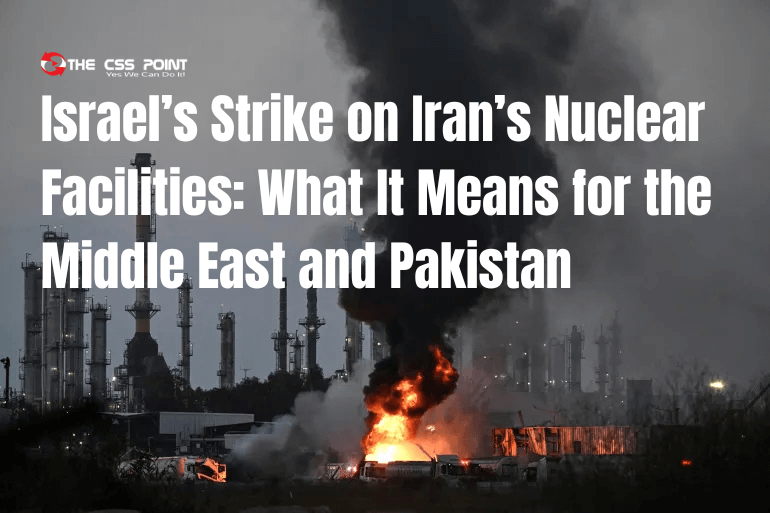
Israel-Iran Conflict: Strategic Objectives and Global Implications
Israel’s Strike on Iran Nuclear Facilities: What It Means for the Middle East and Pakistan. The conflict revolves around two key objectives. One is halting Iran’s path to nuclear weapons. The other is enabling a regime change in Tehran. Unconditional surrender is now demanded by the US-Israel alliance. Nuclear arms in the hands of Iranian clerics are seen as a lasting threat. Consequently, their elimination is considered vital.
The IDF’s strategy is deliberate and widespread. Iran’s military, political leaders, scientists, and infrastructure are all being targeted. Moreover, operations are being conducted against nuclear sites like Natanz, Fordow, and Bushehr. Attacks have also been launched on IR-40 in Arak and elsewhere. This is being done to achieve the dual objective. Iran is viewed by Israel as already unstable. Years of sanctions and political unrest have taken a toll. Hence, continued military pressure is expected to lead to collapse. However, Iran’s nuclear potential must first be eliminated.
For years, Israel has shaped the battlefield environment. Military coercion and diplomacy have been consistently used. Furthermore, cyber-attacks and sabotage have degraded Iran’s 3H network—Hamas, Hezbollah, and Houthis. Covert Mossad operations have reached deep into Iranian systems. Targeted killings of scientists and clerics have been possible only through human intelligence. These actions reflect years of strategic preparation.
Yet Israel cannot act alone. It lacks critical weapons like bunker-buster bombs. Fordow’s fortified facility poses a specific challenge. The IDF also lacks sufficient refueling aircraft. F-15L, F-16, and F-35 jets require mid-air refueling for a 3,000 km mission. The US has started shifting military assets into the region. That support may soon turn into full participation. Consequently, military posturing has increased. Nonetheless, diplomacy remains possible under coercive pressure. Israel’s Strike on Iran’s Nuclear Facilities: What It Means for the Middle East and Pakistan
Netanyahu has sought US involvement from day one. Iran might end up bruised but not destroyed. Its nuclear ambitions may be delayed but not ended. A new power structure could emerge in Tehran. The US appears to be letting Israel wear down Iran. Then, a nuclear deal on unfavorable terms can be forced. This strategy would damage Iran’s leadership. Meanwhile, Hezbollah has been neutralized through Israeli military action. That could be a test case for a broader US-Israel blueprint.
US Involvement, Regional Fallout, and Pakistan’s Strategic Considerations
US involvement brings several legal and military concerns. War declarations without Congress are unconstitutional. Even so, such actions have often bypassed legal challenges. Direct US attacks on nuclear sites could cause radiation leaks. That would set a dangerous global precedent. Moreover, 50,000 US troops in the Middle East would be vulnerable. Bases in 19 locations could face retaliation. Iran has so far been precise in its targeting. But desperation could trigger serious mistakes.
A broader war would destabilize the region. Iran shares borders with six nations including Iraq and Pakistan. Fourteen maritime neighbors also lie within reach. Internal turmoil in Iran could fuel sectarian tension. Particularly, Iraq—where US troops remain based—could be impacted. US installations at Al Asad, Habbaniyah, and Marez are exposed. Iraq’s strong alliance with Iran adds further complexity.
Netanyahu’s influence on US policy is well known. His worldview is shaped by a rigid, polarizing mindset. The global Jewish community should take note. Continued support for his aggression might backfire. Growing anti-Zionist sentiment could intensify worldwide. The US should not get dragged into an unpopular war. Instead, diplomacy must be strongly pursued.
Netanyahu remains defiant. Trump is unpredictable. A ceasefire seems distant. Israel is sustaining damage, albeit limited. Thus, conflict escalation appears likely. Recent US threats, including calls for Khamenei’s death, may be strategic. These could be aimed at forcing negotiations—not actual combat. Israel’s Strike on Iran Nuclear Facilities: What It Means for the Middle East and Pakistan
Iran’s missile arsenal remains its primary weapon. Yet continued attacks could reduce its effectiveness. Israel’s defense systems intercept most threats. Only around 11% of Iranian hypersonic missiles breach its shield. Still, Israeli civilians experience fear and trauma. The population remains under constant psychological stress. Iran might retaliate economically by closing the Strait of Hormuz. That would disrupt 20% of global oil shipments.
Pakistan must consider long-term security implications. Netanyahu views its nuclear program with suspicion. His remarks about its “extremist ideology” are well documented. His influence on US policy is widely acknowledged. For Pakistan, strategic upgrades are essential. Drone capabilities must be enhanced immediately. Hypersonic missile development should be prioritized. Defensive systems and air force readiness need urgent strengthening. Modi’s India remains a continuous threat. Whether or not Israel is involved, danger persists. Pakistan’s Navy must also be prepared to defeat any blockade attempt. Israel’s Strike on Iran Nuclear Facilities: What It Means for the Middle East and Pakistan

